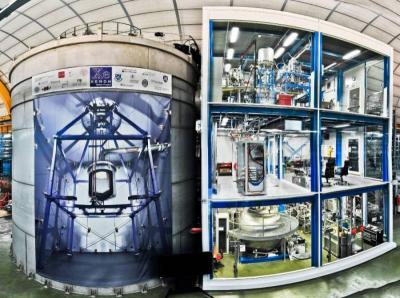
After pushing the boundary of dark matter searches into new territory on several fronts XENON1T was stopped and is currently being upgraded to the second generation (G2) direct detection dark matter experiment XENONnT in Hall B at the Laboratori Nazionali del Gran Sasso (LNGS) underground laboratory in Italy. The XENON collaboration pioneered its two-phase liquid xenon detector technology and consistently maintained its lead in exploiting it. The picture shows a fish-eye view of XENON1T before the upgrade got underway, with a poster of the inside of its cosmic muon veto tank draped onto that tank. New technologies and further improvements on established ones are currently being integrated both inside the tank and inside the glass-windowed, three-storied XENON tech-building seen to its right.
Kavli IPMU is leading the Japanese participation in the current upgrade from XENON1T to XENONnT, the final step in the XENON program. XENONnT is designed to detect possible WIMP Dark Matter interactions with the xenon nuclei in the target mass down to cross sections of a few times 10-48 cm2 for a 50 GeV/c2 WIMP. With XMASS colleagues from ICRR at the University of Tokyo, Nagoya University, and Kobe University we bring XMASS expertise in particular in xenon purification and radon monitoring and mitigation from Kamioka to LNGS. In the collaboration's effort to design the best neutron veto surrounding the XENONnT liquid xenon time projection chamber our Japanese technology developed for Super-Kamiokande in Kamioka was selected: XENONnT will use a gadolinium sulfate loaded water Cherenkov to veto neutrons emerging from the xenon target mass. At the level of sensitivity aimed for by XENONnT it becomes imperative to veto neutron associated events where neutrons produced in the ubiquitous (alpha/neutron) reactions in the detector material escape from this target mass.
Of course all of us are looking forward to extract the best science from the best XENONnT detector that the collaboration's combined knowledge and experience can build. Pushing boundaries across the range from detector technology and cleanliness to the final physics output is our focus, here at Kavli IPMU and all collaborating institutions. Stay tuned.
(Last update: 2019/10/25)
Links
- Dark Matter Detection
- Astroparticle Physics
- Detector/Instrument Development
- XENON Experiment Home page






